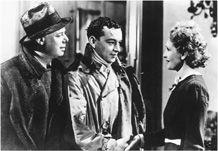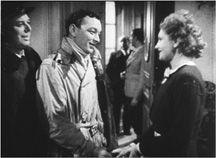B0041VYHGW EBOK (21 page)
Authors: David Bordwell,Kristin Thompson

Rick Lyman had the intriguing idea of asking a director or performer to choose a film and comment on it as it was screening. The results are in
Watching Movies: The Biggest Names in Cinema Talk About the Films That Matter Most
(New York: Henry Holt, 2003). See also Mark Cousins’s
Scene by Scene: Film Actors and Directors Discuss Their Work
(London: Laurence King, 2002).
In mass-production filmmaking, the screenwriter is expected to follow traditional storytelling patterns. For several decades, Hollywood has called for scripts about strong central characters who struggle to achieve well-defined goals. According to most experts, a script ought to have a three-act structure, with the first-act climax coming about a quarter of the way into the film, the second-act climax appearing about three-quarters of the way through, and the climax of the final act resolving the protagonist’s problem. Writers will also be expected to include
plot points,
twists that turn the action in new directions.
These formulas are discussed in Syd Field,
Screenplay: The Foundations of Screenwriting
(New York: Delta, 1979); Linda Seger,
Making a Good Script Great
(New York: Dodd, Mead, 1987); and Michael Hauge,
Writing Screenplays That Sell
(New York: HarperCollins, 1988). Kristin Thompson has argued that many finished films have not three but four major parts, depending on how the protagonist defines and changes important goals. See her
Storytelling in the New Hollywood: Understanding Classical Narrative Technique
(Cambridge, MA: Harvard University Press, 1999). See also David Bordwell,
The Way Hollywood Tells It: Story and Style in Modern Movies
(Berkeley: University of California Press, 2006). Older but still useful books on screenwriting are Eugene Vale,
The Technique of Screenplay Writing
(New York: Grosset & Dunlap, 1972), and Lewis Herman,
A Practical Manual of Screen Playwriting for Theater and Television Films
(New York: New American Library, 1974).
Filmmaker J. J. Murphy identifies and examines the distinctive conventions of independent screenplay writing in
Me and You and Memento and Fargo: How Independent Screenplays Work
(New York: Continuum, 2007).
Roger Ebert provides an entertaining collection of overworked storytelling conventions in
Ebert’s Little Movie Glossary
(Kansas City: Andrews & McMeel, 1994). Learn about “The Fallacy of the Talking Killer “and “The Moe Rule of Bomb Disposal.”
There are few studies of artisanal and collective film production, but here are some informative works. On Jean Rouch, see Mick Eaton, ed.,
Anthropology—Reality—Cinema: The Films of Jean Rouch
(London: British Film Institute, 1979). The makers of
Harlan County, U.S.A.
and other independent documentaries discuss their production methods in Alan Rosenthal,
The Documentary Conscience: A Casebook in Film Making
(Berkeley: University of California Press, 1980). Maya Deren’s work is analyzed in P. Adams Sitney,
Visionary Film: The American Avant Garde, 1943–2000,
3rd ed. (New York: Oxford University Press, 2002). Stan Brakhage ruminates on his approach to filmmaking in
Brakhage Scrapbook: Collected Writings
(New Paltz, NY: Documentext, 1982). For information on other experimentalists, see Scott MacDonald,
A Critical Cinema: Interviews with Independent Filmmakers
(Berkeley: University of California Press, 1988), and David E. James,
Allegories of Cinema: American Film in the Sixties
(Princeton, NJ: Princeton University Press, 1989).
Collective film production is the subject of Bill Nichols,
Newsreel: Documentary Filmmaking on the American Left
(New York: Arno, 1980), and Michael Renov, “Newsreel: Old and New—Towards an Historical Profile,”
Film Quarterly
41, 1 (Fall 1987): 20–33. Collective production in film and other media is discussed in John Downing,
Radical Media: The Political Experience of Alternative Communication
(Boston: South End Press, 1984).
The DIY movement has largely been fostered on the Internet. For the DIY Film Festival, see its homepage,
www.diyconvention.com/
. The 48 Hour Film Project is here:
www.48hourfilm.com/
. Many of the films can be found on the website or on YouTube, where a search on either “DIY film” or “48 Hour Film Project” yields thousands of results. For a list of the cities that hold screenings of locally made 48 Hour films, see
en.wikipedia.org/wiki/48_Hour_Film_ Project
. New Zealand has created its own version, 48Hours; see
www.48hours.co.nz
. Films from this festival can be found at YouTube by searching “48 Hour New Zealand.”
A film may live in our memory as much through photographs as through our experiences of the movie. The photograph may be a copy of a single frame taken from the finished film; this is usually called a
frame enlargement.
Most movie photographs we see in books and magazines, however, are
production stills,
images shot by a still photographer on the set.
Production stills are usually photographically clearer than frame enlargements, and they can be useful for studying details of setting or costume. But they differ from the image on the filmstrip. Usually, the still photographer rearranges and relights the actors and takes the shot from an angle and distance not comparable to that shown in the finished film. Frame enlargements therefore offer a much more faithful record of the finished film.
For example, both
1.57
and
1.58
have been used to illustrate discussion of Jean Renoir’s
Rules of the Game.
In
1.57
, a production still, the actors have been posed for the most balanced composition and the clearest view of all three. It is not, however, faithful to the finished film. The actual shot from the film is shown in
1.58
. The frame enlargement shows that the composition is looser than that of the production still. The frame enlargement also reveals that Renoir uses the central doorway to suggest action taking place in depth. Here, as often happens, a production still does not capture important features of the director’s visual style.

1.57 A production still from Renoir’s
The Rules of the Game.

1.58 A frame from
The Rules of the Game.
Virtually all of the photographs in this book are frame enlargements.
General Reference
www.imdb.com/
A basic reference for films, people, and companies worldwide. The Power Search is particularly helpful. Not infallible, so double-check on other sites.
www.afi.chadwyck.com/
The American Film Institute catalogue of U.S. motion pictures. Offers detailed film-by-film information, including extensive plot synopses. Proprietary site accessed through libraries.
www.fii.chadwyck.com/
A Film Index International site containing bibliographical information about films and people. Accessed through libraries.
For a description of two useful podcasts on filmmaking and the movie industry, see “Movies on the radio,” at
www.davidbordwell.net/blog/?p=902
.
www.cjr.org/tools/owners/
The
Columbia Journalism Review
site on media conglomerates, with up-to-date lists of holdings.
www.boxofficemojo.com/
Lists U.S. and international gross receipts for current films, as well as records of films released in previous decades.
www.indiewire.com/
Provides current information on U.S. independent cinema.
www.wis-kino.com/kino.htm/
Offers links to the worldwide Kino movement.
www.aintitcoolnews.com/
A popular film fansite hosted by Harry Knowles.
www.mpaa.org/
The official site of the major distribution companies, with heavy emphasis on antipiracy activities.
www.natoonline.org/
The official site of the National Association of Theatre Owners, with some statistics.
For a description of two useful podcasts on filmmaking and the movie industry, see “Movies on the radio,” at
www.davidbordwell.net/blog/?p=902
.
Sunday Morning Shootout: Best of Season 1.
Peter Bart, editor of
Variety,
and Peter Guber of Mandalay Pictures discuss current industry trends. Our marginal quotation from Stacy Sher comes from the third disc in this set.
Before laser discs and DVDs, making-of documentaries weren’t common, but some documentaries on older films have been put together using modern cast and crew interviews, finished footage, still photography, and other material. Excellent examples of these include “The Making of
American Graffiti,
” “The Making of
Jaws,
” “The Making of
Amadeus,
” “Guns for Hire: The Making of
The Magnificent Seven,
” and “Destination Hitchcock: The Making of
North by Northwest.
” The supplements for
Alien
are grouped in “preproduction,” “production,” and “postproduction” sections, and a particularly good example of a screen test (Sigourney Weaver) is included. “The Making of
20,000 Leagues Under the Sea
” is one of several supplements on the DVD for that film, making it an unusually thorough treatment of an older film (1954).
Once the laser disc and especially the DVD age began, supplements came to be a part of the filmmaking process, with on-set footage and interviews planned in advance. A good early example is “The Making of
Jurassic Park,
” with its accompanying supplements. As the popularity of DVD supplements became apparent, longer and more systematic supplements were concocted. An outstanding example is “The Hundred Days” documentary for
Master and Commander.
The extended-edition DVDs for
The Lord of the Rings
raised the bar for in-depth coverage, with two supplemental discs for each entry in the trilogy.
Supplements often include storyboard images as galleries. Director Ridley Scott trained in painting and design, and some of the impressive storyboard images that he created for
Alien
are covered in its supplements. The “Story” section of
Toy Story
’s documentaries shows scenes of a storyboard artist explaining the action to the main filmmakers, with the sketches shown side-by-side with his presentation. Later the storyboard images are compared with the final images.
Many making-ofs stick to the most prominent parts of filmmaking: design, musical composition, casting. Occasionally, however, unusual aspects of the process receive coverage. Take animal wrangling. Horses are the obvious topic, and the “Home of the Horse Lords” track of the
Lord of the Rings: The Return of the King
deals with them. “Inside the Labyrinth,” a making-of for
The Silence of the Lambs,
includes a moth wrangler. One of the funniest of such segments must be “Attack of the Squirrels” on the
Charlie and the Chocolate Factory
DVD.
